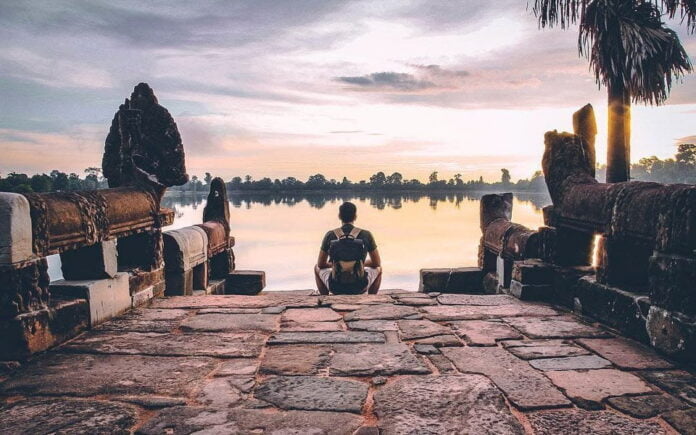This 10th Century baray, or reservoir, is a magical setting for its visitors, who admire a serene sunrise from its cross-shaped, laterite landing stage. Under the watchful eye of two lion guardian statues, enjoy the view of the baray, which has remained at least partially flooded since its heyday in King Rajendravarman II’s rule.
How to get there
Located 1km south of the East Baray and east of Banteay Kdei, the terrace is accessed via steps from the road, which lies at a lower level than the baray’s banks, affording a view across the water as you approach.
When to visit
Sunrise is a popular time to visit Srah Srang, as it offers a peaceful alternative to the crowded Angkor Wat.
History
Although the name suggests its purpose was for royal bathing, inscriptions found on the site, dating back to the mid-10th Century, point to a more inclusive intention – providing water ‘for the benefit of all creatures’.
The possibility that there was once a temple built on an artificial island in the centre of the 700m x 300m reservoir was discovered when stones, similar to those used for East Mebon, were found. Changes to the structure of Srah Srang occurred in the 12th Century when Jayavarman VII added a terrace to its western side and lined the pond with sandstone. The additions to the original structure are likely to have coincided with the East Baray having accumulated sediment, causing it to cease functioning efficiently. An alternative source of water for the population would have been required – Srah Srang being a convenient choice.
Architecture
Srah Srang has all the elements of a romantic setting, with its surrounding greenery, its grand landing stage and sweeping views across the water, reflecting a sunrise or a setting sun. Serpent balustrades that lead down to the water from the platform are flanked by two majestic lions. Visitors will also find a large garuda riding a three-headed serpent, which rests on a platform along with other mythical creatures. The Bayon-style architecture so favoured at the time, was the work of King Rajendravarman’s preferred architect, Kavindrarimathana.



